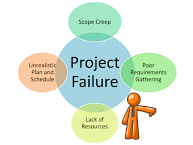Every project is unique, yet the root cause of project failure is usually the same. when we know these reasons, we can minimize the chances of problems and increase the probability of a project succeeding.
so what should we do when we are faced with rough project initiation, weak controls, lack of resources, project risks, and unrealistic expectations? here are five common problems and solutions to learn from.
simple rough project startup
perhaps the most common problem is not starting the project correctly, which is really just taking the time to gather customer needs, agree to customer requirements, create a good project plan, and set customer expectations. and people always tend to work quickly on projects. however, a simple and rough project startup phase can often lead to problems and even project failures.
do not undertake project work until the correct project initiation process is complete. if a client pushes you to work on a project based on assumptions in order to get deliverables early, don't agree. in fact, a simple and rough project start can lead to rework, errors, oversights, and only worsen the project. so, when a project is pushed unreasonably, you can only say "no" and never start too early.
project control is too weak
even if the plan is thorough and the start-up is sufficient, it is meaningless if it cannot be effectively managed. typical problems caused by lack of control include: escalating scope, oversimplified work schedules, lack of change control, lack of communication, and management of risk issues.
(1) establish a change management process and make these controls known to all. use these processes with ensuring your team stays focused and delivers the critical stuff.
(2) use exception reporting. this ensures better attention when risks and problems arise.
(3) communicate regularly with customers, promoters and other important project stakeholders.
(4) regularly review and update the project plan. if the project plan is not reviewed and updated, there is no need to make a plan.
lack of manpower and skills
projects are understaffed, or the number of people with the right mix of skills often leads to project failure. when your project doesn't have enough people with the right skills, it's really frustrating. this problem is very common in current project management.
insist that management provide the right people, whether it's from within or hiring outsourced contract employees. use a solid project plan to illustrate where you still need to invest people to support your requirements. don't be silent and hold on, it's not fair to you and your team.
risks and problems are not emphasized
in the life cycle of a project, there are many occasions where risks and anomalies can lead to problems or even failures. examples include:
(1) without a clearly defined requirement, the result does not meet the customer's expectations.
(2) the use of cutting-edge new technologies leads to unforeseen problems.
(3) the overly simple technical design makes it possible to change and scale the future method.
(4) invalid change control causes the change requirement to cause the project to deviate from the original goal.
(5) insufficient testing leads to errors and defects left on the product.
(6) lack of support from key figures at critical moments.
review the list of risks and issues at the beginning of the project. one of the best ways to do this is to use brainstorming to list possible risks and problems, including project members, other project managers who have worked on similar projects, and so on. risks and issues are continuously reviewed throughout the project.
the workarounds in the example above include:
(1) hire business analysts to outline the needs of customers and record them with clear and unambiguous documentation.
(2) ask whether cutting-edge new technologies must be used, and whether the latter has more ways to provide the same functionality.
(3) technical design by your team. this gives you a great chance of getting a reliable and flexible design, and your team has a foundational design that you can continue to use.
(4) a process of change control is reached with the customer before the project is started, and it is strictly implemented according to the process.
(5) put the test plan together with the test scenarios formulated according to customer requirements. make sure you have enough resources and a commitment from your customers to test.
(6) develop a contingency plan for the risk of losing key people.
inability to effectively manage customer expectations
usually projects start on the basis of a lot of optimistic estimates. over the life of a project, client expectations inflate to the point where they simply aren't realistic, and when clients don't know what they should expect or they can't see how the project actually progresses, they'll be disappointed in you and your relationship will break down.
it is the responsibility of the project manager to manage the expected value to a reasonable level. one way to do this is to break down a project into individual task blocks or project stages with multiple milestones. you can release cyclical deliverables to your customers so they can see what they're going to get.
in this way, the client can see what you are doing at an early stage, ensuring that the project deliverables meet the client's expectations.








No comments:
Post a Comment